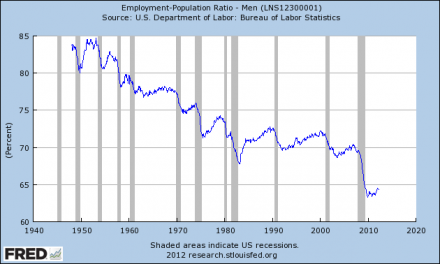 Once upon a time in America, virtually anyone with a high school education and the willingness to work hard could get a good job. Fifty years ago a “good job” would enable someone to own a home, buy a car, take a couple of vacations a year and retire with a decent pension. Unfortunately, those days are long gone. Every single year the number of “good jobs” in the United States actually shrinks even as our population continues to grow. Where in the world did all of those good jobs go? Economists toss around terms such as “outsourcing” and “offshoring” to describe what is happening, but most ordinary Americans don’t really grasp what those terms mean. So what is outsourcing? Well, it essentially means sending work somewhere else. In the context of this article I will be using those terms to describe the thousands of manufacturing facilities and the millions of jobs that have been sent overseas. Over the past several decades, the U.S. economy has become increasingly merged into the emerging “one world economy”. Thanks to the WTO, NAFTA and a whole host of other “free trade” agreements, the internationalist dream of a truly “global marketplace” is closer than ever before.
Once upon a time in America, virtually anyone with a high school education and the willingness to work hard could get a good job. Fifty years ago a “good job” would enable someone to own a home, buy a car, take a couple of vacations a year and retire with a decent pension. Unfortunately, those days are long gone. Every single year the number of “good jobs” in the United States actually shrinks even as our population continues to grow. Where in the world did all of those good jobs go? Economists toss around terms such as “outsourcing” and “offshoring” to describe what is happening, but most ordinary Americans don’t really grasp what those terms mean. So what is outsourcing? Well, it essentially means sending work somewhere else. In the context of this article I will be using those terms to describe the thousands of manufacturing facilities and the millions of jobs that have been sent overseas. Over the past several decades, the U.S. economy has become increasingly merged into the emerging “one world economy”. Thanks to the WTO, NAFTA and a whole host of other “free trade” agreements, the internationalist dream of a truly “global marketplace” is closer than ever before.
But for American workers, a “global marketplace” is really bad news. In the United States, businesses are subject to a vast array of very complex laws, rules and regulations that make it very difficult to operate in this country. That makes it very tempting for corporations to simply move out of the U.S. in order to avoid all of the hassle.
In addition, the United States now has the highest corporate tax rate in the entire world. This also provides great motivation for corporations to move operations outside of the country.
The biggest thing affecting American workers, however, is the fact that labor has now become a global commodity. U.S. workers have now been merged into a global labor pool. Americans must now directly compete for jobs with hundreds of millions of desperate people willing to work for slave labor wages on the other side of the globe.
So exactly how is an American worker supposed to compete with a highly motivated person on the other side of the planet that makes $1.50 an hour with essentially no benefits?
Just think about it.
If you were a big global corporation, would you want to hire American workers which would cost you 10 or 20 times more after everything is factored in?
It doesn’t take a rocket scientist to figure out why millions of jobs have been leaving the United States.
Corporations love to make more money. Many of them will not hesitate for an instant to pay slave labor wages if they can get away with it. The bottom line for most corporations is to maximize shareholder wealth.
Slowly but surely the number of good jobs in the United States is shrinking and those jobs are being sent to places where labor is cheaper.
According to the U.S. Commerce Department, U.S. multinational corporations added 2.4 million new jobs overseas during the first decade of this century. But during that same time frame U.S. multinational corporations cut a total of 2.9 million jobs inside the United States.
So where are all of our jobs going?
They are going to places like China.
The United States has lost an average of 50,000 manufacturing jobs per month since China joined the World Trade Organization in 2001.
In addition, over 40,000 manufacturing facilities in the United States have been closed permanently during the past decade.
What do you think is eventually going to happen if the U.S. economy continues to bleed jobs and factories so badly?
As the U.S. has faltered, China has become an absolute economic powerhouse.
Ten years ago, the U.S. economy was three times as large as the Chinese economy. At the turn of the century the United States accounted for well over 20 percent of global GDP and China accounted for significantly less than 10 percent of global GDP. But since that time our share of global GDP has been steadily declining and China’s share has been steadily rising.
According to the IMF, China will pass the United States and will become the largest economy in the world in 2016.
Should we all celebrate when that happens?
Should we all chant “We’re Number 2”?
Our economy is falling to pieces and the competition for the few remaining good jobs has become super intense.
The average American family is having a really tough time right now. Only 45.4% of Americans had a job during 2010. The last time the employment level was that low was back in 1983.
Not only that, only 66.8% of American men had a job last year. That was the lowest level that has ever been recorded in all of U.S. history.
Just think about that.
33.2% of American men do not have jobs.
And that figure is going to continue to rise unless something is done about these economic trends.
Today, there are 10% fewer “middle class jobs” in the United States than there were a decade ago. Tens of millions of Americans have been forced to take “whatever they can get”. A lot of very hard working people are basically working for peanuts at this point. In fact, half of all American workers now earn $505 or less per week.
Things have gotten so bad that tens of thousands of people showed up for the National Hiring Day that McDonald’s just held. With the economy such a mess, flipping burgers or welcoming people to Wal-Mart are jobs that suddenly don’t look so bad.
Right now America is rapidly losing high paying jobs and they are being replaced by low paying jobs. According to a recent report from the National Employment Law Project, higher wage industries accounted for 40 percent of the job losses over the past 12 months but only 14 percent of the job growth. Lower wage industries accounted for just 23 percent of the job losses over the past 12 months and a whopping 49 percent of the job growth.
Thanks to the emerging one world economy, the U.S. is “transitioning” from a manufacturing economy to a service economy.
But it certainly doesn’t help that China is using every trick in the book to steal our industries. China openly subsidizes domestic industries, they brazenly steal technology and they manipulate currency rates.
A recent article on Economy In Crisis described how the Chinese paper industry has been able to grow by threefold over the past decade while the U.S. paper industry has fallen apart….
From 2002 to 2009, the Chinese government poured $33.1 billion into what should be an unproductive industry. But, with the help of government subsidies, China was able to ride export-driven growth to become the world’s leading producer of paper products.
In the same time frame that China pumped $33 billion into its paper industry, U.S. employment in the industry fell 29 percent, from 557,000 workers to just 398,000.
So why should we be concerned about all of this?
Well, just open up your eyes. As I have written about previously, our formerly great cities are being transformed into post-apocalyptic hellholes.
In a comment to a recent article, Trucker Mark described what he has seen happen to the “rust belt” over the past several decades….
I am a product of Detroit’s northwest suburbs and the Cleveland, OH area, where together I lived almost 2/3rds of my 54 years. As a 30-year semi driver, I am intimately familiar with large areas of the industrial Midwest, the Northeast, and even much of central and southern California, and everything in-between. I am also college-educated, in Urban Planning and Economics. What has happened to not just Detroit, but to virtually every city in the southern half of Lower Michigan and northern Ohio is mind-boggling. When I was 18, it was quite common to head over to a car plant and get hired immediately into a middle-class job. At one time I had dozens of friends from school working at car plants, dozens more in other large factories, dozens more in major grocery warehousing and distribution, and me, I was a semi driver delivering to all of those places. Between 1979, when I started driving semis, and now, I must have seen 10s of thousands of factories across just the southern Great Lakes region close their doors. Some of them were small, and some of them employed 10,000 workers or more.
The former Packard plant from your photo closed in 1957, and at one time it employed 12,000 workers, and my roommate in 1982 in Birmingham, MI had been laid-off from the old Dodge Main plant in Hamtramck, which once employed over 20,000 workers, which closed in 1981. In 1970 just Chrysler had over 40 plants in the Detroit-area, and now there are just 11 left open. The Willow Run plant, which at one time turned-out a brand-new B-29 bomber every 40 minutes, and employed 50,000 workers, is long dead too, as is the tank plant north of town too. Even fairly new car plants like Novi Assembly are closed, Pontiac’s ultra-modern robotic car assembly plant too. In Cleveland 100 or more huge old plants stand empty, car plants, steel mills, and machine tool builders, in Akron dozens of rubber plants are long gone, Sharon, Warren, and Youngstown have all lost huge numbers of industrial jobs, Canton and Massillon too, where the NFL started, have been reduced to mere shells of their former selves. Along with the plant closings have gone the hopes and dreams of many thousands of retail operators, restaurant owners, and thousands of other small businesses too. Hundreds of entire major shopping malls stand vacant, as seas of potholes consume local roads. The city of Hamtramck, MI a Detroit suburb of 40,000 people, is bankrupt and has had to layoff all but two employees, one of whom works part-time. The traffic lights are shut-off and stop signs now appear at those intersections instead, as the city can’t even pay its power bill. I could go on & on & on for days but I don’t have the time.
I haven’t driven a semi in almost 2 years as my eyesight has begun giving out early. My last 10 years in the industry was spent delivering fresh and frozen meat on a regular multi-stop route through the Chicago-area and throughout southern Michigan. Between 2001 and 2009, my boss lost 14 of 19 major weekly customers in Michigan to bankruptcy, including three major grocery chains, plus numerous less-frequent customers. The Detroit News reported before Christmas of 2007 a 29% unemployment rate within the city limits of Detroit, with an estimated 44% of the total adult population not working, and another news story reported a 1 in 200 chance of selling a house across the entire metropolitan area, which still has 4 million people total. Since 2003, home prices within the city limits of Detroit have fallen by 90%, and today there are thousands of houses in move-in condition on the market there for $5K to $10K. The suburbs are not immune either.
You know what? Detroit and Cleveland used to be two of the greatest cities in the entire world.
Today very few people would call them great. They are just shells of their former glory.
Sadly, this cruel economy is causing “ghost towns” to appear all across the United States. There are quite a few counties across the nation that now have home vacancy rates of over 50%.
Another reader, Flubadub, also remembers how things used to be….
I am also a product of that generation and remember well the opportunities that existed for anyone with even a high school diploma in those days. Just within a reasonable commute to where I grew up we had US Steel, 3M, General Motors Fisher Body, Nabisco, The Budd Co., Strick Trailer and others providing thousands of jobs that enabled you to provide a decent living for your family. There were also plenty of part time jobs to keep high school students busy enough to avoid the pratfalls of idle youth and afford the 28 cent/ gallon gas for their used cars. Most of it is gone now and I don’t blame the Mexicans or the Chinese for stealing it. I blame the greed of the globalists and their flunkies, the phony free trade advocates in office, who’ve spent the last twenty years giving it all away.
Our jobs are being shipped overseas so that greedy corporate executives can pad their bonuses and our politicians are allowing them to get away with it.
According to a new report from the AFL-CIO, the average CEO made 343 times more money than the average American did last year.
Life is great if you are a CEO.
Life is not so great if you are an average American worker trying to raise a family.
Another reader, Itsjustme, says that things are also quite depressing In New Jersey….
I live in northern NJ in a suburb a very short ride from NYC.
Our region was hit very hard — we once had a very prosperous and booming industrial area; mixed use with many warehouses and commercial buildings, hirise and lowrise.
The majority of companies that were in those buildings are gone. Long vacant; the signage is left and nobody is inside them.
One large commercical building with 15 floors now is home to 2 tenants: a law firm and a Korean shipping company.
It’s very sad what’s happened out here.
The only “companies” moving into these buildings are small change tenants that that are usually Chinese or Middle Eastern; you’ll see them subletting out 2 or 3 offices in these buildings and they operate out of those offices. They’re mostly importers of apparel or soft goods.
My guess is that they are there on very short term leases.
This will benefit our local and state economy not. These groups usually send the money home.
If this is the shape of things to come, we can hang it up right now. No viable companies are moving into our area; if anything new is being built it is retail and service industry garbage, like crummy fast food chain restaurants. No livable wage jobs are entering our local economy.
As I have written about previously, the standard of living of the middle class is being pushed down to third world levels. We have been merged into a “global labor pool”, and what that means is that the standard of living of all workers all over the world is going to be slowly equalized over time.
Our politicians never told us that all of these “free trade” agreements would mean that soon we would be living like the rest of the world.
America used to be the greatest economic machine on the planet. But now we are just another region of the one world economy that has workers that are too expensive to be useful.
In the end, there is not some great mystery as to why we are experiencing economic decline as a nation.
If millions of our jobs are being shipped overseas, it was basically inevitable that we were going to experience a housing crisis. Without good jobs the American people simply cannot afford high mortgage payments.
Today we consume far more wealth as a nation than we produce. We have tried to make up the difference by indulging in the greatest debt binge that the world has ever seen.
We have lived like kings and queens, but our debt-fueled prosperity is not sustainable. In fact, the collapse of our financial system is a lot closer than most people would like to believe.
Things did not have to turn out like this, but we bought into the lies and the propaganda that our leaders were feeding us.
Now our economy lies in tatters and our children have no economic future.
 This economic decline has been really hard on everyone, but it has been particularly hard on American men. During the last recession male employment dropped like a rock and it has not recovered much at all since then. That is why many referred to the last recession as a “mancession”. Industries where men are disproportionately represented such as construction and manufacturing have really been hit hard in recent years. In the old days, you could take a high school education down to the local factory and get a job that would enable you to live a middle class lifestyle and support a growing family on just that one income. Sadly, those days are long gone. Today, American men live in a world where their labor is not really needed. Wages are falling because almost any worker can be easily replaced by the vast pool of unemployed American workers that are currently searching for work, and a lot of big companies are shifting labor-intensive jobs overseas where workers only make a small fraction of what they make in the United States. American workers (especially those without much education) are considered to be expensive liabilities in a world where labor has become a global commodity. So the percentage of working age American men that have jobs is likely to continue to decline and wages are likely to continue to stagnate as well.
This economic decline has been really hard on everyone, but it has been particularly hard on American men. During the last recession male employment dropped like a rock and it has not recovered much at all since then. That is why many referred to the last recession as a “mancession”. Industries where men are disproportionately represented such as construction and manufacturing have really been hit hard in recent years. In the old days, you could take a high school education down to the local factory and get a job that would enable you to live a middle class lifestyle and support a growing family on just that one income. Sadly, those days are long gone. Today, American men live in a world where their labor is not really needed. Wages are falling because almost any worker can be easily replaced by the vast pool of unemployed American workers that are currently searching for work, and a lot of big companies are shifting labor-intensive jobs overseas where workers only make a small fraction of what they make in the United States. American workers (especially those without much education) are considered to be expensive liabilities in a world where labor has become a global commodity. So the percentage of working age American men that have jobs is likely to continue to decline and wages are likely to continue to stagnate as well.





